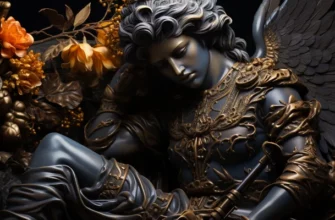Aphrodite is one of the most famous goddesses in ancient Greek mythology, the embodiment of beauty, love, passion, and fertility. She has inspired poets, artists, and sculptors for thousands of years, and her myths combine tenderness, strength, and deep human emotions. According to the most common version, Aphrodite was born from sea foam off the coast of Cyprus after Cronus overthrew his father Uranus. Another version says that she is the daughter of Zeus and Dione. Aphrodite symbolizes love, passion, and feminine beauty, often depicted with doves, roses, and seashells, which have become her symbols.
In mythology, she is known for her love for the mortal youth Adonis, who died while hunting, and from his blood grew anemones, flowers that symbolize grief for lost love. She took part in a dispute with Heracles and Athena, promising Paris the most beautiful woman, Helen, which led to the Trojan War. Aphrodite was married to Hephaestus, the god of blacksmithing, but her heart belonged to Ares, the god of war. Her cult is especially widespread in Cyprus, Kipher, and Corinth, where festivals were dedicated to her and shrines were built.
The image of Aphrodite has become a symbol of beauty in art — famous paintings and sculptures, such as Botticelli’s “The Birth of Venus” and the statue “Aphrodite of Milos.” Aphrodite is not only the goddess of beauty, but also the embodiment of the power of love, capable of inspiring and healing, and sometimes destroying, reminding us of the importance of emotions and harmony in life.
Legends and myths
Aphrodite, the ancient Greek goddess of love and beauty, was the subject of numerous legends and myths. According to one version, she was born from the thigh of the sea god Uranus, which the god Cronus tore off his father and threw into the sea. Another myth links Aphrodite’s birth to the sperm of the god Zeus, which fell into the sea after his castration. She is also known for her romantic relationship with the god of war, Ares, and her disagreements with other goddesses, which often ended in scandals and battles. Legends about Aphrodite reveal her controversial character and role in the life of the ancient Greek pantheon.
The legend of Aphrodite’s birth
Long ago, when the world was just beginning to take shape, a struggle broke out between the heavenly titans. Uranus, the god of the sky, was a cruel ruler, and his son Cronus decided to overthrow his father. Armed with a sickle, Cronus overthrew Uranus and cut off part of his body, which he threw into the sea.
When the drops of blood and pieces of Uranus’ body fell into the sea foam, the waves began to glow with a strange light. From this foam, a beautiful goddess was born — Aphrodite. She emerged from the sea waves near the coast of the island of Cyprus, appearing on a huge shell carried by the waves.
When she stepped onto the ground, everything around her blossomed: flowers and grass appeared, and even the gods on Mount Olympus were enchanted by her beauty. Aphrodite became the goddess of love, beauty, and harmony. Her appearance brought not only passion to the world, but also the power of love, capable of healing hearts and inspiring great deeds.
The legend of Aphrodite and Adonis
Once upon a time, the goddess of love, Aphrodite, saw an extremely handsome young man named Adonis. He was mortal, but so beautiful that even the goddess’s heart trembled with love. Aphrodite could no longer be away from him — she descended from Olympus and began to spend every day with him.
They walked together in the woods, listened to the birds singing, and enjoyed the beauty of nature. But Adonis loved hunting, and despite Aphrodite’s pleas to be careful, he once went into the woods alone.
He was attacked by a wild boar — according to some versions, it was the god of war, Ares, who was jealous of Aphrodite. Adonis was mortally wounded. Aphrodite rushed to him, but it was too late — her beloved died in her arms.
In despair, she shed tears that fell to the ground and mixed with Adonis’ blood. From this sad beauty, a flower grew — the anemone, which has since symbolized the transience of life and love.
In order not to lose him forever, Aphrodite turned to Zeus. He agreed: Adonis would spend part of each year in the world of the living with her, and part in the realm of the dead with Persephone.
The legend of the quarrel between the goddesses and the apple of discord
All the gods were invited to the wedding of the Greek hero Peleus and the nymph Thetis, except for Eris, the goddess of strife. Offended, she decided to take revenge. During the banquet, she threw a golden apple with the inscription: “To the most beautiful.”
Three goddesses immediately claimed that the apple belonged to them: Hera, the goddess of power; Athena, the goddess of wisdom and war; and Aphrodite, the goddess of love and beauty.
Zeus did not want to interfere in the women’s dispute and entrusted the choice to Paris, the handsome prince of Troy. Each of the goddesses tried to bribe the young man:
- Hera promised to make him ruler of the world,
- Athena promised to grant him boundless wisdom and victory in battle,
- Aphrodite promised him the most beautiful woman in the world as his wife.
Paris chose Aphrodite, and she gave him the love of Helen of Troy, the wife of the Spartan king Menelaus. Paris kidnapped Helen and brought her to Troy.
This marked the beginning of the Trojan War, which pitted the most powerful heroes of Greece and Troy against each other and ended with the fall of Troy — all because of an apple and a dispute between goddesses.
The origin of Aphrodite
There are several versions of Aphrodite’s origin. One of them links her birth to the foam of the sea god Uranus, which was torn off by the god Cronus and thrown into the sea. Aphrodite was born from this foam. Another myth links her appearance to the sperm of the god Zeus, which fell into the sea after his castration. According to this version, the sea foam that formed turned into Aphrodite. Regardless of her origin, Aphrodite became the goddess of love, beauty, and sexuality, inspiring admiration and influencing the lives of the ancient Greek pantheon.
Attributes and symbols
Aphrodite, the ancient Greek goddess of love and beauty, has her own distinctive attributes and symbols. One of Aphrodite’s most famous attributes is sea foam or foam, which is associated with her origin. She was often depicted next to water or a bath. Another important symbol is doves, which were considered sacred birds of the goddess. It is also associated with her maritime associations. In addition, Aphrodite was depicted with her son Eros, the god of love, who is her constant companion and assistant. These attributes and symbols emphasize her role in love, beauty, and sexuality, which is embodied in her image.
Features and appearance
Aphrodite, the ancient Greek goddess of love and beauty, was usually depicted as an extremely attractive woman with flawless physical beauty. She had long, lush hair. Her eyes were expressive and full of sexual appeal. Aphrodite’s face was delicate and healthy, with gentle features and flawless skin. She was always depicted in elegant and luxurious outfits that emphasized her femininity and sexuality. All these features and Aphrodite’s appearance symbolize the ideal of beauty and charm embodied in her divine image.
The cult of Aphrodite
The cult of Aphrodite in ancient Greece included various shrines and temples where rituals and ceremonies dedicated to the goddess of love and beauty were performed. Among the most famous shrines of Aphrodite are the temples in Kition, Kydonia, Athens, and Corinth. In these shrines, sacrifices, prayers, and rituals were performed to attract her blessings and favors. Rituals and ceremonies included dancing, singing, bowing, and making promises, especially before weddings and to the goddess. The cult of Aphrodite was supported by a community that believed in the power of the goddess of love and her influence on interpersonal relationships and family happiness.
Influence on art and culture
Aphrodite, as the goddess of love and beauty, had a significant influence on the art and culture of ancient Greece. Her image and symbols were reflected in various art forms, such as sculpture, painting, poetry, and literature. Sculptures of Aphrodite depicted her immense beauty and elegance, creating an ideal of beauty. Her image also inspired poets and writers, who praised her passion and influence on people. The cult of Aphrodite encouraged creativity and the expression of emotions in art. In addition, Aphrodite was present in rituals related to love, marriage, and reproduction, which influenced gender and social aspects of Greek society. Overall, the cult of Aphrodite played an important role in shaping aesthetics, morality, and the perception of beauty in ancient Greek art and culture.
Conclusion
Aphrodite, the ancient Greek goddess of love and beauty, held a special place in the mythology and culture of Ancient Greece. Her image symbolized the ideal of beauty, sexuality, and passion. The cult of Aphrodite played an important role in shaping the art, literature, and social norms of the time. The legends associated with Aphrodite and her influence on art and culture have enriched the heritage of ancient Greek civilization. The goddess of love, Aphrodite, remains an important figure in world mythology to this day, embodying the beautiful and magical power of love and attraction.








